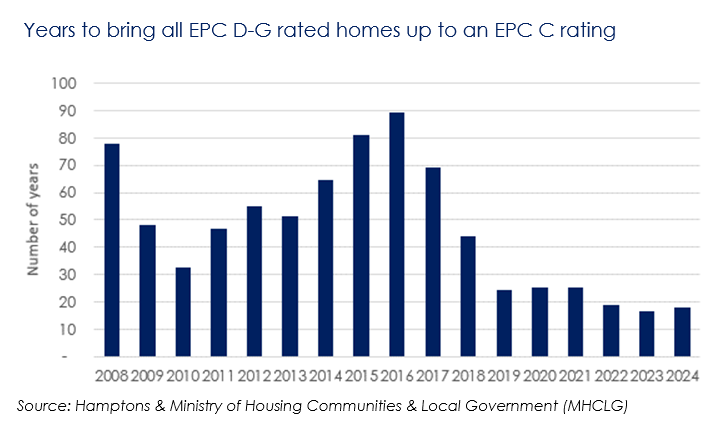Hamptons report reveals how long it will take for rental properties to achieve government target

Privately rented homes in England and Wales are unlikely to meet proposed energy efficiency standards before 2042, according to recent data from the residential estate agent Hamptons.
At the current pace of improvements, Hamptons said it will take another 18 years for all rental properties to achieve an energy performance certificate (EPC) rating of ‘A’ to ‘C’. This timeline is well beyond the government’s target of 2030 but marks a significant acceleration from the 89 years it would have taken at 2016 improvement rates.
In 2024, 39% of rental properties that underwent EPC assessments moved into a higher energy efficiency band. Although this is an improvement over long-term averages, it falls short of the upgrade rates seen before 2018, when the requirement for a minimum EPC rating of ‘E’ was introduced.
To meet the 2030 target, approximately 340,000 rental homes must improve their EPC ratings each year. Current data suggest that around 115,000 homes will achieve an EPC ‘C’ rating in 2024, necessitating a threefold increase in upgrade efforts annually until the end of the decade.

So far in 2024, 55% of all privately rented homes that received a new EPC certificate achieved a rating of ‘C’ or better, compared to 48% of owner-occupied homes. Half of the homes previously rated ‘D’ improved to at least a ‘C’, while 29% of those rated ‘E’ reached ‘C’ or above. In contrast, only 9% of homes rated ‘C’ advanced to a ‘B’ rating.
Data from the latest Hamptons Monthly Lettings Index also indicates that 3 to 4% of rented homes will be unable to achieve an EPC rating of ‘A’ to ‘C’, though this figure has dropped from 7 to 8% before changes to the EPC methodology in mid-2022. The updated methodology reduced the assumed environmental impact of electrical appliances, sometimes resulting in higher ratings for homes heated by electricity rather than gas.
Hamptons noted that properties with lower EPC ratings are often older, cheaper, and located in the North of England. These homes, which are typically less energy-efficient, yield higher rental returns. In 2024, homes with an EPC ‘D’ rating offered a gross yield of 7.6%, compared to 5.5% for EPC ‘A’-rated properties. EPC ‘E’-rated homes delivered the highest yields at 7.9%. However, the cost of upgrading these properties to meet the proposed energy standards may be prohibitive for many landlords.
For tenants, Hamptons said higher EPC ratings can lead to significant savings on energy bills, particularly as prices continue to rise. Upgrading a home from an EPC ‘D’ to ‘C’ rating could save tenants £499 annually, a 76% increase in savings since 2019. Tenants in EPC ‘E’-rated homes could save up to £1,248 per year, an 83% increase since 2019.
“Successive changes to proposed energy efficiency rules have shifted the goalposts for landlords, some of whom face costs which can run into tens of thousands of pounds,” said Aneisha Beveridge (pictured), head of research at Hamptons. “Despite this, many investors have continued to improve the energy efficiency of their rental homes and we’re currently on track to see 100% of rental homes where an EPC ‘A’ to ‘C’ is viable, reach that rating within a generation.
“To meet the government’s 2030 target, the same number of homes will need to see energy upgrades over the next five years as we’ve seen make improvements in the last 30 years. While a requirement for all rental homes to achieve an EPC ‘A’ to ‘C’ rating by 2030 is achievable at a stretch, landlords need adequate time and resources to meet it. It is essential landlords receive complete clarity on this target this year.”
Rents continue to go up
Rental prices across Great Britain continued to rise in July, driven by double-digit increases in the North of England. The average rent for a newly let property increased to £1,354 per month, a 5.7% rise compared to July 2023. This marks the 12th consecutive month of rising rents, although the pace of growth has moderated.

Outside London, rents grew by 7.2% year-on-year, with the North of England experiencing a 10.3% increase. This region has seen accelerated rent growth since March. Rents in the North are now rising three times faster than in London, where the average rent on a new tenancy increased by 3% year-on-year, down from the 13.9% increase recorded in July 2023. Despite this, rents in Inner London have returned to growth after three consecutive months of decline.
The rental market has also seen a shift towards smaller properties, with tenants downsizing to manage costs. The average rent for a one-bedroom home rose by 7.6% to £1,092 per month in July, while three-bedroom and four-bedroom properties saw more modest increases of 5.2% and 3.8%, respectively. The cost of renting a one-bedroom property is now equivalent to the price of a two-bedroom property in September 2022.
“Rental growth continues to outpace inflation, despite the pace of growth moderating over the last year,” Beveridge said. “However, there are also signs that the large increases in stock levels since 2023 are beginning to subside.
“In January, stock levels were up 34% year-on-year, a figure which is now 22%. A fall in stock levels is likely to reignite the pace of rental growth, particularly given that longer-term there are around a third fewer rental homes than there were five years ago.”
Want to be regularly updated with mortgage news and features? Get exclusive interviews, breaking news, and industry events in your inbox – subscribe to our FREE daily newsletter. You can also follow us on Facebook, X (formerly Twitter), and LinkedIn.



